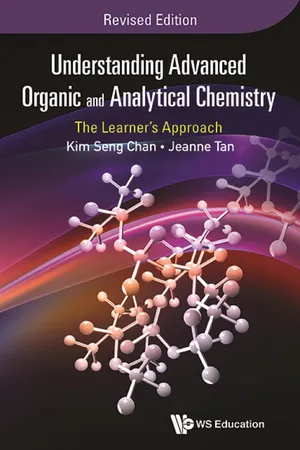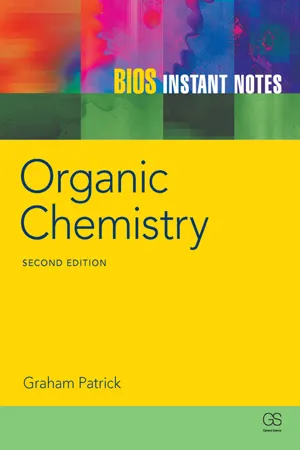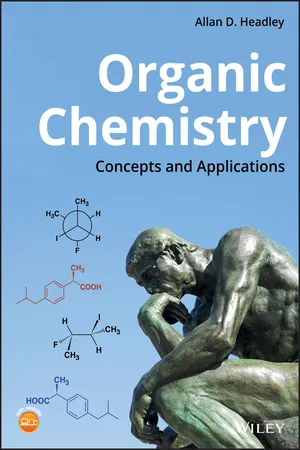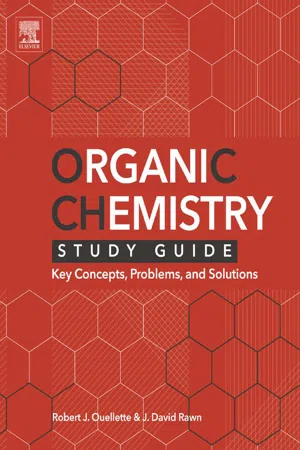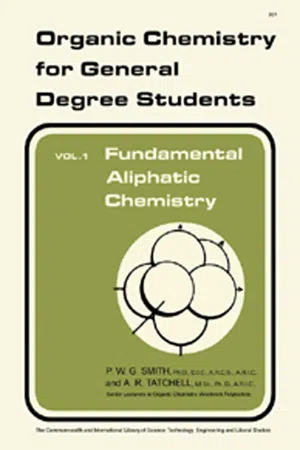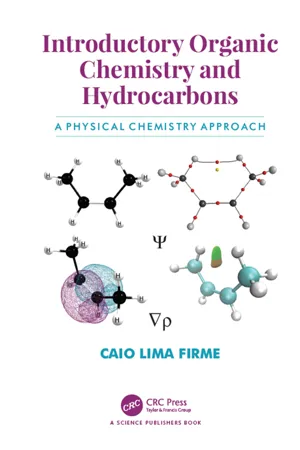Chemistry
Halogenoalkanes
Halogenoalkanes, also known as alkyl halides, are organic compounds containing one or more halogen atoms (fluorine, chlorine, bromine, or iodine) bonded to an alkane carbon chain. They are widely used in organic synthesis and as intermediates in the production of pharmaceuticals, agrochemicals, and other industrial chemicals. Halogenoalkanes are classified based on the number and position of halogen atoms in the molecule.
Written by Perlego with AI-assistance
Related key terms
Related key terms
1 of 4
Related key terms
1 of 3
8 Key excerpts on "Halogenoalkanes"
- eBook - ePub
Understanding Advanced Organic and Analytical Chemistry
The Learner's ApproachRevised Edition
- Kim Seng Chan, Jeanne Tan;;;(Authors)
- 2016(Publication Date)
- WS EDUCATION(Publisher)
CHAPTER 7
Halogen Derivatives
7.1 Introduction
Halogenoalkanes, also known as alkyl halides, are saturated organic compounds that contain the −C−X functional group (X = F, Cl, Br or I). They are important derivatives of alkanes and have the general formula Cn H2n+1 X. An example is bromoethane:Halogenoalkanes do not occur naturally. In fact, they are the by-products of the reaction of alkanes or alkenes with halogen, as these hydrocarbons are commonly found in petroleum. Halogenoalkanes are generally known as the “workhorse” in organic chemistry as they are very useful intermediates to be converted to other more important specialty chemicals of greater economic value. Some Halogenoalkanes, such as chlorofluorocarbon, can also be harmful to the environment.Halogenoarenes (or aryl halides) are aromatic compounds with a halogen atom directly attached to the benzene ring. Similar to Halogenoalkanes, halogenoarenes do not occur naturally and are in fact synthesized by reacting aromatic compounds isolated from petroleum with halogens.7.2 Nomenclature
A halogenolkane is obtained when one or more hydrogen atoms of an alkane molecule have been replaced by halogen atoms via the free radical substitution reaction. Other than this, Halogenoalkanes can also be obtained when hydrogen halide (HX) or the diatomic halogen molecules add across an alkene double bond through the electrophilic addition mechanism. Thus, one can simply perceive Halogenoalkanes as substituted alkanes. Therefore, Halogenoalkanes are named in a similar manner to alkanes — the suffix ends in — ane - eBook - ePub
- Andrew F. Parsons(Author)
- 2013(Publication Date)
- Wiley(Publisher)
5 HalogenoalkanesKey point . Halogenoalkanes (RX) are composed of an alkyl group bonded to a halogen atom (X = F, Cl, Br or I). As halogen atoms are more electronegative than carbon, the C–X bond is polar and nucleophiles can attack the slightly positive carbon atom. This leads to the halogen atom being replaced by the nucleophile in a nucleophilic substitution reaction and this can occur by either an SN1 (two-step ) or SN2 (concerted or one-step) mechanism . In competition with substitution is elimination , which results in the loss of HX from Halogenoalkanes to form alkenes. This can occur by either an E1 (two-step ) or E2 (concerted ) mechanism . The mechanism of the substitution or elimination reaction depends on the structure of the halogenoalkane, the solvent and the nucleophile/base.5.1 Structure
Halogenoalkanes, R–X, have an alkyl group (R) joined to a halogen atom by a single bond. The larger the size of the halogen atom (X = I > Br > Cl > F), the weaker the C–X bond (Appendix 1). With the exception of C–I, the C–X bond is polar; the carbon atom bears a slight positive charge and the electronegative halogen atom bears a slight negative charge.The use of hashed and wedged line notation is discussed in Section 3.3.2 Hybridisation is introduced in Section 1.5 Naming Halogenoalkanes is discussed in Section 2.4Halogenoalkanes have an sp3 carbon atom and so have a tetrahedral shape.- An aliphatic halogenoalkane has the carbon atoms in a chain and not a closed ring, e.g. 1-bromohexane, CH3 (CH2 )5 Br.
- An alicyclic halogenoalkane has the carbon atoms in a closed ring, but the ring is not aromatic, e.g. bromocyclohexane, C6 H11 Br.
- An aromatic halogenoalkane has the carbon atoms in a closed ring and the ring is aromatic, e.g. bromobenzene, C6 H5
- eBook - ePub
- Graham Patrick(Author)
- 2004(Publication Date)
- Taylor & Francis(Publisher)
SECTION L — ALKYL HALIDESL1 Preparation and physical properties of alkyl halides
Key Notes
Preparation Alkenes are converted to alkyl halides by reaction with hydrogen halides. Treatment with halogens results in dihaloalkanes. Tertiary alcohols can be converted to alkyl halides on treatment with hydrogen halides, whereas primary and secondary alcohols are best converted by using thionyl chloride or phosphorus tribromide. Structure Alkyl halides consist of an alkyl group linked to a halogen. The carbon linked to the halogen is sp 3 hybridized and tetrahedral. The carbon–halogen bond length increases and the bond strength decreases as the halogen increases in size. Bonding The C–halogen bond (C–X) is a polar σ bond where the halogen is slightly negative and the carbon is slightly positive. Intermolecular bonding is by weak van der Waals interactions. Properties Alkyl halides have a dipole moment. They are poorly soluble in water, but dissolve in organic solvents. They react as electrophiles at the carbon center. Reactions Alkyl halides undergo nucleophilic substitution reactions and elimination reactions. Spectroscopic analysis The presence of a halogen atom can be shown by IR spectroscopy (C–X stretching absorptions) as well as by mass spectrometry. The latter shows a characteristic pattern of peaks for the molecular ion that matches the number and ratio of naturally occurring isotopes of the halogen. Elemental analysis also demonstrates the presence of halogens. Related topics (A3) sp 3 Hybridization (C3) Intermolecular bonding (C4) Properties and reactions (H3) Electrophilic addition to symmetrical alkenes (M4) Reactions of alcohols (P3) Infra-red spectroscopy (P4) Proton nuclear magnetic resonance spectroscopy (P6) Mass spectrometry Preparation
Alkenes can be treated with hydrogen halides (HCl, HBr, and HI) or halogens (Cl2 and Br2 ) to give alkyl halides and dihaloalkanes respectively (Section H3 ). An extremely useful method of preparing alkyl halides is to treat an alcohol with a hydrogen halide (HX = HCl, HBr, or HI). The reaction works best for tertiary alcohols (Section M4 ). Primary and secondary alcohols can be converted to alkyl halides more effectively by treating them with thionyl chloride (SOCl2 ) or phosphorus tribromide (PBr3 - eBook - ePub
Organic Chemistry
Concepts and Applications
- Allan D. Headley(Author)
- 2019(Publication Date)
- Wiley(Publisher)
14 Free Radical Substitution Reactions Involving Alkanes14.1 Introduction
Saturated hydrocarbons, also called alkanes, are fairly unreactive, but they do undergo some reaction types mentioned in Chapter 6 . We have seen that most alkanes readily undergo oxidation under specific reaction conditions to liberate heat, along with water and carbon dioxide. In this chapter, we will examine another reaction type that alkanes undergo, and that is substitution reactions. Substitution reactions involving different types of alkanes with chlorine or bromine in the presence of energy in the form of heat or light to form much more reactive compounds, alkyl halides will be examined. Alkyl halides are used frequently for the synthesis of larger and other useful compounds, which will be covered in this chapter. We have already covered some of the reactions of alky halides, which include elimination reactions. Alkyl halides are alkanes in which one or more of the hydrogens of the alkanes has been substituted for one or more halogens. The usual representation of alkyl halides is R‐X, where R represents the alkyl group, and X represents the halogen. Some alkyl halides are used as solvents in organic and industrial labs. Such halogenated solvents are immiscible with water and are denser than water (Figure 14.1 ).Chloroform was one of the first compounds discovered to induce general anesthesia. The use of this compound opened the possibility to perform surgery on patients who became unconscious when vapors of chloroform were inhaled. It was later discovered that chloroform is toxic and carcinogenic, so its use for this purpose was stopped. Several compounds, such as N2 O and BrClCHCF3 , have been used instead. Over the years, less toxic alkyl halides, such as ethyl chloride haloethane and isoflurane, were used.Chlorofluorocarbon s (CFC s) are very volatile compounds, and they were used as the propellant for aerosols in deodorants, paints, hair spray, and other spray products. They are also called Freon and are used as refrigerants in air conditioners, refrigerators, and freezers. Since these CFCs are inert compounds, they were considered ideal volatile propellants until in the 1970s, it was discovered that they ultimately find their way to the stratosphere where they deplete the ozone (O3 - eBook - ePub
Organic Chemistry Study Guide
Key Concepts, Problems, and Solutions
- Robert J. Ouellette, J. David Rawn(Authors)
- 2014(Publication Date)
- Elsevier(Publisher)
9Haloalkanes and Alcohols Introduction to Nucleophilic Substitution and Elimination Reactions
Keys to the Chapter
9.1 Functionalized Hydrocarbons
In this chapter, we discuss the chemistry of haloalkanes and alcohols in which the halogen or hydroxy! group is bonded to an sp3 -hybridized carbon atom. Molecules with sp2 -hybridized carbon atoms bonded to a halogen or a hydroxyl group have different chemistry. We will discuss these compounds in later chapters. Haloalkanes and alcohols are classified as 1°, 2°, and 3° by the same method used to classify carbon atoms in alkanes.9.2 Nomenclature of Haloalkanes
The rules for naming haloalkanes are very similar to the rules for naming alkanes (Section 4.3 ) and alkenes (Section 5.6 ). Halogen atoms and branching alkyl groups have equal priorities in terms of their positions in the parent chain. If no other functional groups are present, the chain is numbered from the end closest to the first substituent, whether it is a halogen or an alkyl group. However, the double bond of an alkene or the triple bond of an alkyne takes precedence in numbering a carbon chain, regardless of where the halogen is located or how many halogens there may be. The concept of the priority of one functional group over another is expanded with each new functional group we will study in later chapters. It is explicitly part of R ,S configurational nomenclature.9.3 Nomenclature of Alcohols
The common names of simple alcohols are based on the name of the alkyl group bonded to the hydroxyl group, as in methyl alcohol. The IUPAC method of naming alcohols is based on the longest continuous carbon chain that contains a hydroxyl group. The chain is numbered to give the carbon atom bonded to the hydroxyl group the lowest possible number. The suffix -ol - eBook - ePub
Fundamental Aliphatic Chemistry
Organic Chemistry for General Degree Students
- P. W. G. Smith, A. R. Tatchell(Authors)
- 2014(Publication Date)
- Pergamon(Publisher)
IVHalogen Derivatives of Aliphatic Hydrocarbons*
Publisher Summary
The monosubstituted compounds are known as alkyl halides and can be represented by the general formula Cn H2n+1 X, where X denotes any halogen atom. The complete series of alkyl halides can be derived by replacing any hydrogen atom in paraffin by the appropriate halogen atom. The simplest members of the alkyl halide series are gases or volatile liquids. The boiling points throughout the series progressively increase with increasing molecular weight. Alkyl halides are covalent compounds being almost insoluble in water though readily soluble in organic solvents. Their inertness and insolubihty in cold concentrated sulfuric acid is exploited as their method of purification because this reagent removes alcohols and olefins that may be present as contaminants. The monohalogen derivatives of the alkanes are prepared from paraffins, olefins, alcohols, or carboxylic acids and by methods involving halogen exchange. The alkyl halides undergo a number of important reactions in which halogen is replaced by another monovalent group. These substitution reactions are also accompanied by elimination reactions to give olefins. Alkyl halides are also used in the laboratory to form organometallic compounds, which find wide use as synthetic intermediates.THE ALKYL HALIDES
As has been noted previously the main reaction of the paraffins is that of substitution by the halogens, to yield halogenated hydrocarbons. The monosubstituted compounds are known as the alkyl halides, and can be represented by the general formula Cn H2n +1X where X denotes any halogen atom. The complete series of alkyl halides can therefore be derived by replacing any hydrogen atom in a paraffin by the appropriate halogen atom. The common and also the systematic method of naming these compounds is illustrated with reference to the following alkyl chlorides which may be derived from the simple paraffins. For example, methane CH4 and ethane CH3 ·CH3 , lead to methyl chloride CH3 Cl (systematically chloromethane) and ethyl chloride CH3 ·CH2 - eBook - ePub
Occupational Exposures
Chemical Carcinogens and Mutagens
- Frances Alston, Onwuka Okorie(Authors)
- 2023(Publication Date)
- CRC Press(Publisher)
6.3 Halogenated organic compounds
Halogenated organic compounds represent a large class of natural and synthetic chemicals that contain one or more halogens (fluorine, chlorine, bromine, or iodine) combined with carbon and other elements. The simplest organochlorine compound is chloromethane, also called methyl chloride (CH3 Cl) (Organic Halogen Compounds – Chemistry Encyclopedia – reaction, elements, examples, gas, number, atom, synthesis, reactivity (chemistryexplained.com ).Sodium hypochlorite (bleach – NaOCl) and many organic chemicals contained in household cleaning products can react to produce halogenated volatile organic compounds (VOCs) as validated through experimentation.6 The experiment results also add credence to the fact that bleach can be important in terms of inhalation of carbon tetrachloride, chloroform, and several other halogenated VOCs.6 With this knowledge, consumers must keep in mind that usage of halogenated organic compounds comes with risks. These risks can be minimized by knowing the product and using the products as prescribed while having in place the safety requirement during usage. Some halogenated organic compounds are listed in Table 6.3 .Table 6.3 Some halogenated organic compoundsBromodichloromethane p-Chloroaniline Carbon tetrachloride p-Chloro-m-cresol Chlorobenzene 2-Chloronaphthalene 2-Chloro-1,3-butadiene 2-Chlorphenol Chlorodibromomethane 3-Chloropropionitrile Chloroethane m-Dichlorobenzene 2-Chloroethyl vinyl ether - eBook - ePub
Introductory Organic Chemistry and Hydrocarbons
A Physical Chemistry Approach
- Caio Lima Firme(Author)
- 2019(Publication Date)
- CRC Press(Publisher)
Chapter FourteenAlkanes (nomenclature, properties, and reactions)
HYDROCARBONS
Hydrocarbons are a class of organic compounds containing only carbon and hydrogen atoms. There are four main types of hydrocarbons: alkanes, alkenes, alkynes (aliphatic compounds), and aromatic compounds, besides alkadienes and polyenes. Aliphatic compounds (non-aromatic hydrocarbons) can be open-chain compounds (acyclic) or closed-chain compounds (cyclic). Alkanes just have single C-C bonds. Alkenes just have one double C=C bond (and all other single C-C bonds for alkenes higher than ethane). Alkynes just have one triple C≡C bond (and all other single C-C bonds for alkynes higher than ethyne). Alkadienes have two double C=C bonds. Polyenes have more than two double C=C bonds. The simplest alkane is methane. The simplest alkene is ethene. The simplest alkyne is ethyne. The iconic aromatic compound is benzene. The simplest alkadiene is butadiene. The simplest polyene is hexatriene. See Fig. 14.1 for their representations.Figure 14.1 Representation of simplest or iconic hydrocarbons.ALKANES
The general formula of alkanes is CnH2n+2. Besides being the simplest alkane, methane is also the most abundant. It is present in the atmosphere, in the oceans (e.g., in methane clathrate – methane trapped in solid, crystal water) and in the Earth’s crust. Ethane and propane are the second and third simplest alkanes and they made up the natural gas along with methane (in largest amount) and butane. All of these compounds are important fossil fuels, along with gasoline, diesel, and kerosene. Alkanes can also be used as solvents, lubricating oil, paraffin wax, and asphalt. Natural gas is obtained from Earth’s crust reservoir and higher alkanes are obtained from petroleum crude oil after its refining process. In the first and main unit of the petroleum refining process, there is a huge distillation tower where the separation of main alkanes takes place. See Table 14.1
Index pages curate the most relevant extracts from our library of academic textbooks. They’ve been created using an in-house natural language model (NLM), each adding context and meaning to key research topics.
Explore more topic indexes
Explore more topic indexes
1 of 6
Explore more topic indexes
1 of 4
